The best 55-inch 4K TVs for 2024: OLED, QLED and more TVs for all budgets
The best 55-inch 4K TVs deliver a great blend of price-to-performance – here are our top picks
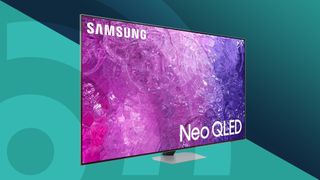
The best 55-inch 4K TVs are a great size for those stepping into the idea of a big, beautiful home theater. 55 inches is the amount of space where 4K resolution, advanced HDR tech and super-smooth gaming features all really step into their own, on a screen big enough to show them off.
The best 55-inch TVs also offer the widest range of pricing and screen technology options – it's where you'll find the best OLED TVs and mini-LED high-end options, affordable QLED, and super-budget standard LED TVs. This is because it's such a popular size – almost everything in our guide to the best TVs has a 55-inch option.
This can mean that shopping among the best 55-inch TVs can feel overwhelming, but a) we're here to help whittle it down to the most worthwhile, and b) this fierce competition means you tend to find fantastic discounts on 55-inch TVs a lot of the year, as companies battle to stand out. We've reviewed every one of the TVs here ourselves, and the list is based on comparing them to the competition and suggesting only the better options, balancing performance against price.
That means we have some older models here – after price cuts since their launch, they might now be the best bang for buck, even when newer models have launched. Gamers will be happy to find that most of the best gaming TVs come in 55-inch sizes too.

I'm TechRadar's Managing Editor for Entertainment, and I've been in tech publishing for over 15 years, including for TechRadar in its earliest days. I've been writing about the latest TVs and soundbars since 2017, and I worked directly with our reviewers and editors to put together the recommendations in this guide, based on our real-world experience with these TVs.
The top 55-inch TVs of 2024, chosen by our testers
Why you can trust TechRadar
Our favorite 55-inch TV you can buy today
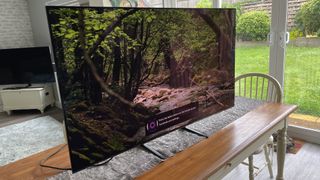
Specifications
Reasons to buy
Reasons to avoid
✅ You want the best value QD-OLED: The S90C gives brilliant QD-OLED performance and picture at a more reasonable price
✅ You have a lot of connectivity needs: The S90C carries great gaming support including a 144Hz refresh rate and Samsung's Game hub.
❌ You want the full QD-OLED experience: The S90C doesn't quite hit the brightness of the S95C or quality of the Sony A95K
❌You need the best smart TV platform: Although improved, the Tizen OS from Samsung could still use some work
The S90C is Samsung's first attempt to make its exciting QD-OLED technology, first introduced in 2022, more affordable without compromising on any of the quality. It mostly succeeds, which is why it's our top recommended pick for most people.
Although not as bright as the S95C, the S90C still offers a fantastic, bright picture that is complimented with rich detail and deep blacks. The LG G3 also provides a brighter picture, but both it and the S95C are much more expensive than the S90C, meaning you still get a brilliant picture without blowing your budget.
The S90C also carries excellent gaming features, with 4K 120Hz on four HDMI ports, VRR support and a dedicated game bar to make this an excellent choice for gamers who are looking to improve their gaming experience. However, like all other Samsungs on the list, it doesn't support Dolby Vision, but we feel the excellent picture quality and brightness more than compensate for this.
You may not be getting all that QD-OLED can offer (look to the S95C for this) but with such a big price difference between the two, the S90C really shows its value. Marrying the brightness of QLED with the detailed blacks of an OLED for less money is a welcome thing and it's this reason that the Samsung S90C is our top overall pick that we think would suit most people looking for a new 55-inch panel.
Read our full Samsung S90C review
Our favorite budget TV in the US

Specifications
Reasons to buy
Reasons to avoid
✅ You want a great gaming TV: The U7N offers high-level gaming features including 4K 120Hz, 144Hz, VRR, and Dolby Vision gaming, making it ideal for PS5 and Xbox Series X.
✅ You want a high-value TV: The U7N’s performance and features rival more expensive sets from Sony and Samsung.
❌ You don't want to mess with picture settings: Getting the best picture out of the U7N requires a good amount of adjustment, which means wading through menus.
❌ You want great built-in sound: While the U7N’s sound quality is adequate, it lacks the spaciousness and punch you’ll hear in TVs from brands like Sony.
The Hisense U7N is a mid-range mini-LED model in the company’s TV lineup and it offers impressive performance at a budget-friendly price, though it costs more in the UK than in the US. Bold colors and natural-looking detail are the main stories here, though it also has plenty of gaming features including 4K 144Hz support.
With a plain but solid design, Dolby Atmos and DTS:X soundtrack support, and the Google TV (VIDAA in the UK) smart TV platform for streaming, the U7N is well-featured for a TV at its price. Along with 144Hz support, it offers Dolby Vision gaming, VRR including AMD FreeSync Premium Pro and Nvidia GSync, and ALLM. Its HDMI 2.1 port count tops out at two, but that limitation is to be expected from a budget TV.
In our Hisense U7N review, we said it “looked very good across the board, showing dynamic and vibrant colors.” Brightness was somewhat limited compared to higher-end mini-LED TVs, including the company’s own Hisense U8K model, and picture settings needed adjustment to get the best image quality, but we found it “hard to argue just how many bases the Hisense U7N covers at the price.”
At under $800 for a 55-inch model, the Hisense U7N brings high-level competition to other TVs on this list, including the Samsung Q80C we selected as our best mid-range 55-inch TV. If you want one of the best mini-LED TVs for less, the U7N is well worth the money.
Read our full Hisense U7N review
Our favorite budget TV in the UK

Specifications
Reasons to buy
Reasons to avoid
✅ You want an excellent value TV: With a mini-LED panel and good suite of gaming features for an affordable price, the C805 is excellent value.
✅ You want a superb picture for the money: Contrast, details, colors and even black levels all look brilliant on the C805 – especially considering the price.
❌ You want cinematic built-in sound: The C805's speakers are fine for day-to-day to use, but a limited soundstage really holds them back.
❌ You need good viewing angles: If you're watching off-center, you'll notice that C805's contrast fades.
The TCL C805 demonstrates outstanding value – at under £600 for its 55-inch size, you get a mini-LED backlight for better local dimming, a good number of gaming features including 4K 120Hz and VRR support, and the Google TV smart TV platform. If you're in the UK, you can't get much better value than the C805 in a 55-inch size.
In our review of the C805, we were seriously impressed by its picture quality, noting that it delivers crisp, refined textures with plenty of detail along with deeper than expected black levels and very good contrast. It also delivered vivid colors with plenty of punch. While its motion could be better and viewing angles are somewhat limted, we said "at this price range, it's hard to be disappointed with the C805's picture".
The C805 is also a great, budget gaming option with two HDMI 2.1 ports that support 4K, 120Hz, VRR (AMD FreeSync Premium Pro) and Dolby Vision gaming all included. Performance is also smooth and judder-free and while its 13.5ms input lag time isn't as good as the very best gaming TVs, it will be good enough for the vast majority of gamers.
The C805's built-in sound lacks the same wow factor that its picture does – although speech and bass are clear and punchy, its soundstage is very limited overall. But with the money you're saving on this TV thanks to its low price tag, you'll have more than enough left over to get a soundbar.
Read our full TCL C805 review
Our favorite elite 55-inch TV
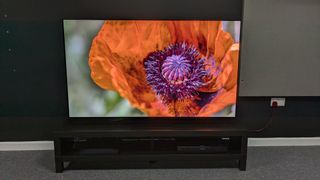
Specifications
Reasons to buy
Reasons to avoid
✅ You want superb picture quality: QD-OLED and AI enhancements combine in the S95D to give you a visually stunning experience.
✅ You want a beautiful design: Its floating stand appearance and external connections box give the S95D a sleek look and feel.
❌ You don't want to tweak Filmmaker Mode: Although it still looks fantastic, there is some black crush on the Filmmaker Mode preset.
❌ You want Dolby Vision: The Samsung S95D is packed with features, but Dolby Vision support for movies or gaming isn't one of them.
The Samsung S95D continues what it's predecessor, the Samsung S95C, did for OLED TVs in combining rich OLED picture quality with the brightness of QLED, called QD-OLED, to create a premium OLED experience. But, the S95D takes things a step further.
AI enhancements mean the S95D has unparalleled levels of detail, giving objects and people near photorealistic appearances. It also still carries the bold colors, superb contrast and deep black levels of its predecessor. As another bonus, it introduces new anti-reflection tech and a matte screen to all but eliminate pesky reflections, ending one of OLED's biggest issues.
The S95D also carries a lot of the same great features of the S95C as well, including its plethora of gaming features, such as 144Hz refresh rate, ALLM, VRR and AMD FreeSync Premium Pro – all across four HDMI 2.1 ports. It also features Samsung's Game Hub, which supports cloud based gaming from Xbox, Nvidia and more and serves as an extremely useful tool for gamers.
It's not just internally but also externally that the S95D demonstrates its premium feel, with a trim profile, floating design giving it a modern appearance and its external connections box, which is ideal for those looking to wall-mount.
Read our full Samsung S95D review
The top 55-inch TV for sports
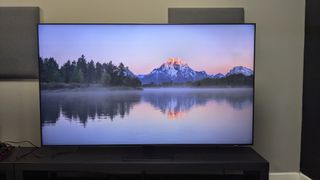
Specifications
Reasons to buy
Reasons to avoid
✅ You have a bright viewing room: The QN90D's high full-screen brightness and anti-glare screen let it handle brighter viewing rooms with ease
✅ You're a sports fan: High brightness, great picture quality and brilliant motion handling make the QN90D ideal for sports
❌ You want the cheapest mini-LED: Budget competition from Hisense and TCL offer many similar features to the QN90D
❌ You want Dolby Vision: The QN90D doesn't support the Dolby Vision HDR format, so if you need it, look elsewhere
The QN90D's excellent brightness levels across the board, fantastic motion handling and effective anti-glare screen make it ideal for sports, particularly during daytime viewing. It also delivers vivid colors, powerful contrast and lifelike detail for those who want to watch more than just sports.
Gamers will be pleased with the QN90D's four HDMI 2.1 ports supporting 4K 144Hz, VRR (AMD FreeSync Premium Pro included), ALLM and HGiG. An ultra-low 9.9ms input lag time and Samsung's useful Gaming Hub round out the QN90D's gaming features, and paired with the fantastic picture, the QN90D is a seriously good gaming TV. The QN90D's sound is also effective and we found it added to sports viewing during our testing due to its effective placement and clear speech.
OLED TVs with their excellent overall picture quality and motion handling may fare better for sport, but the QN90D's full-screen brightness and anti-glare screen give you equivalent performance for less. There are cheaper sets available that are also good for sport, but none match the QN90D in a 55-inch size.
Read our full Samsung QN90D review
A cheap but stunning 55-inch OLED TV
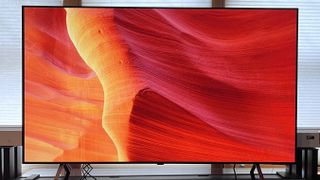
Specifications
Reasons to buy
Reasons to avoid
✅ You want an OLED that won't break the bank: The LG B4 offers serious value thanks to its pixel-perfect contrast for a lower price.
✅ You want a great, all-around OLED: The B4 delivers great picture quality, extensive gaming features, and an intuitive smart TV platform.
❌ You want the brightest OLED: Compared to TVs, even more mid-range models, the B4's brightness is limited.
❌ You don't want to buy a soundbar: The B4's audio is lacking sadly, so to get the most from it you'll need to invest in a soundbar.
If you're looking for a 2024 OLED TV but want to save money, the LG B4 is your best bet. It delivers the OLED picture you'd expect alongside an extensive list of gaming features and a solid smart TV platform for cheaper than any other 55-inch OLED TV.
In our LG B4 review, we were impressed with its overall picture quality, saying that pictures were "crisp and had rich color and great detail even when viewing upconverted non-4K TV shows". When viewing 4K sources, the B4 fared even better, demonstrating those dynamic colors and stunning contrasts with deep black tones that you want from an OLED TV. Motion handling is also exceptional.
The B4 has also seen a gaming upgrade on its predecessor, the LG B3, with four HDMI 2.1 ports and 144Hz refresh rate support. It also supports 4K, 120Hz, VRR (AMD FreeSync and Nvidia GSync included), ALLM and Dolby Vision gaming. It also comes with LG's Game Optimizer for easy gaming setup, including a boost mode that drops input lag to an ultra-low 9.2ms – which is considered suitable for professional level gaming.
The B4 does fall short in some areas, and we found that its sound quality didn't match its pictures, offering crisp audio, but limited bass. Its brightness is lower than that of any other 2024 OLED you can buy, let alone mini-LED TVs, which takes a little shine off its picture. But, when you put its affordable price against its performance, the B4 is a great TV.
Read our full LG B4 review
An awesomely futureproof 55-inch OLED TV
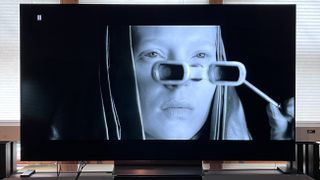
Specifications
Reasons to buy
Reasons to avoid
✅ You want an “affordable” OLED TV
Tthe LG C4 is less expensive than flagship OLED TVs but still offers premium performance and features
✅ You need lots of size options: Not content with being a top 55-inch option, the C4 is available in 42-83 inch screen sizes
❌You want the brightest possible OLED TV
The LG C4 is brighter than last year’s C3, but flagship models like the LG G3 or Samsung S95D offer even better brightness
❌ You are expecting stellar audio for the money: The LG C4 has lots of sound settings, but it is still lacking compared to other TVs
The LG C3 was our previous pick for the best TV for versatility and the new LG C4 now takes that mantle from its predecessor. LG’s mid-range OLED TV offers a compelling mix of features and performance and manages to do it at a price that’s easier on the wallet than flagship OLED TVs from LG and Samsung.
LG’s C4 has a new Alpha 9 AI Processor 4K Gen7 processor that, among other picture-enhancing features, provides a Brightness Booster that delivers a real increase in picture brightness over the C3. HDR support includes Dolby Vision, HDR10, and HLG, and the C4 has a new Dolby Vision Filmmaker Mode preset that gives you a director-approved picture without having to fuss with picture settings.
With virtual 9.1.2-channel upmixing, the LG C4’s built-in 2.2-channel speakers do a more than adequate job of providing spacious Dolby Atmos audio, though you’ll get a better experience by pairing it with one of the best soundbars. The C4 is also a great gaming TV, with its four HDMI 2.1 ports providing 4K 120Hz pass-through, VRR, ALLM, and Quick Media Switching. And LG’s 2024 TVs are 144Hz-certified by Nvidia, making them a perfect option for PC gaming.
The LG C4’s picture brightness boost puts it on par with the Samsung S90C at the top of this list as the best overall 55-inch TV. We haven’t yet tested the new Samsung S90D to see how it racks up against the LG C4, but for now, the S90C remains our top choice since it rivals the C4 when it comes to performance and features and is widely available at a much lower price.
Read our full LG C4 review
A great mid-range gaming 55-inch TV
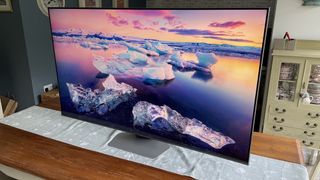
Specifications
Reasons to buy
Reasons to avoid
✅ You want a good range of gaming features: With four HDMI 2.1 ports that offer 4K 120Hz, VRR and ALLM, the Q80D is well-equipped for gaming.
✅ You want an excellent picture: The Q80D's picture is excellent at this price, showing rich contrast, crisp textures and bold color.
❌ You want the best picture out-of-the-box: The Q80D's color in its picture presets can be a little off, so some tweaking is required to get it looking right.
❌ You want Dolby Vision: Like all Samsung TVs, the Q80D doesn't support Dolby Vision for either games or movies and TV shows.
The Samsung Q80D is a high-quality QLED TV, with a superb picture, surprisingly strong sound, and great gaming features and performance, all of which would suggest a far more pricey TV than this affordable, mid-range Samsung.
First and foremost, the Q80D's picture quality is nothing short of brilliant. We were suitably impressed with its bold, vibrant colors and razor-sharp details, but even more so with its deep black levels and rich contrast. In our review we also noted its effective backlight control, saying that "the local dimming system that’s largely responsible for this black level depth works its magic while throwing up impressively few backlight blooming or clouding issues."
Gamers will be pleased by the Q80D's list of features at this mid-range price, with four HDMI 2.1 ports that all support 4K 120Hz, VRR (in both HDMI and AMD FreeSync Premium Pro formats) and ALLM. The Q80D's performance is also great, with a low 9.8ms input lag time and a bold, colorful picture to match.
The Q80D's sound is also effective – a rarity at this price range. We found during our testing that the Q80D not only had a wide soundstage, but effective sound placement around the screen and beyond. It also delivers suitably punchy bass and clear speech. We said the Q80D is "one of the best-sounding TVs in Samsung’s 2024 range" – no mean feat considering it sits below several more premium mini-LED (Neo QLED) and OLED models.
At this price, very few other 55-inch sets will top the Q80D, which almost disguises itself as a premium TV in the body of a mid-range model.
Read our full Samsung Q80D review
The elite 55-inch TV designed for wall-mounting

Specifications
Reasons to buy
Reasons to avoid
✅ You want outstanding picture quality: Expect vibrant colors, punchy and dynamic images, stunning black levels, and improved HDR brightness to top it all off.
✅ You want a TV for the wall: With a specially designed slim-fit wall mount and razor thin profile, the G4 is perfect for the wall.
❌ You want the sound to match the picture: While still credible, the G4's sound doesn't match up to that of Sony and Panasonic's TVs.
❌ You want HDR10+ support: The G4 supports Dolby Vision, but doesn't support HDR10+.
The LG G4 is an outstanding OLED TV that screams premium, delivering superb picture quality with added brightness thanks to the built-in, second generation micro lens array (MLA) tech, a full suite of gaming features and a gorgeous physical design that makes it ideal for wall-mounting – made easier with the option for an included bespoke wall-mount bracket instead of the stand, if you prefer.
With a razor thin depth of 1-inch (2.5cm), the G4 sits flush to the wall when mounted, and with the slim-fit wall-mount, installation is easy and gives a really premium and professional look. Along with its bezel-less screen, the G4 is perfect for those who are all about design.
In our review of the G4, we were blown away by its picture quality as we found it delivered superb, rich contrast, spectacular colors and lifelike details with 4K images – with an added brightness boost from its MLA. We also found that non-4K images were given a real lift by the G4's effective upscaling. We also said that "In practice, the combination of the new panel and processor is nothing short of phenomenal" and it's why the G4 is one of the top OLED TVs of 2024.
Gaming as always is well covered by one of LG's top TVs, and the G4 comes equipped with four HDMI 2.1 ports, supporting 4K up to 144Hz, VRR (AMD FreeSync and Nvidia G-Sync included) as well as Dolby Vision gaming, its performance is buttery smooth as well, with a low 9.2ms input lag time thanks to the Game Optimizer mode.
Read our full LG G4 review
How to choose the best 55-inch TV
What is the best 55-inch smart TV?
Right now, the best 55-inch TV available, that sits at the top of our list, is the Samsung S90C. It combines the best of what makes an OLED (deep blacks and superb contrast) with QLED (high brightness levels) into one outstanding package. Not only that, but it does it for a competitive price too.
How much should you pay for a 55-inch TV?
55-inch TVs can be very cheap, with some budget LCD models costing just $400 / £400 – though that number will double for mid mid-tier options, if not triple and quadruple for high-end screens with OLED panels or Mini LED backlighting. A brand new 55-inch OLED will usually cost around $1,799 / £1,799, for example.
Is a 55-inch smart TV big enough?
55-inch TVs are the flagship size for today's televisions. That makes it pretty much the most common sizing option. It's a kind of happy medium between the best 43-inch TVs and the best 75-inch TVs.
It's worth thinking hard about how important screen size is to you, though. You'll likely pay less for smaller screens, and we're seeing more and more option among the best 50-inch TVs that offer premium screen tech, including OLED.
However, larger screens are increasingly becoming the norm for those that can fit them into their home, and mass production means a big-screen display isn't quite the bank-breaking cost that it used to be.
A bigger screen means more detail that's more easily visible at a larger distance, and a better sense of immersion. Keep in mind, though, that picture defects are also more visible at larger sizes, so you should make sure that you're getting a TV good enough to warrant a step-up in screen size.
What should I look for in a 55-inch TV?
At this ample size, you should absolutely be looking for some good features – lest you get stuck with a large screen that simply blows up artefacts and visual defects.
OLED or mini-LED screens are well worth getting at this size, without the truly extravagant price points of larger models – 55 inch TVs offer a smart, well-judged entry point to premium TV tech. For LCD models, you want to make sure you're getting direct full array lighting rather than the edge lighting still found on some budget sets, which limits the consistency of brightness across the screen.
Otherwise, 4K HDR is a given, and you may want to check that HDMI 2.1 is included if you're partial to gaming, with the VRR (variable refresh rate) and ALLM (auto low latency mode) support usually thrown in.
How we test the best 55-inch TVs
We use the same methods to test the best 55-inch TVs as we do across all our other TV buying guides. This testing criteria is broken down by picture quality (looking at particular elements such as contrast, color and so on), audio quality of built-in speakers, gaming features, smart TV platform, ease of use, design and value for money. We base our testing on subjective opinion and objective measurements of the picture quality, which we take using specialized equipment.
Firstly, we’ll run in the TVs across various types of AV sources, such as broadcast, streaming and 4K Blu-ray. During this time, we’ll cycle through the different picture presets found on each set, such as Standard, Movie and Sport, to establish what we see as the most accurate for that set. We then watch the same movies, TV shows and so on again, making notes of how they compare to each other.
When analyzing picture quality, we’ll use a mixture of sources such as 4K Blu-ray and streaming to look at color reproduction and accuracy, contrast and black levels, and textures. We’ll then use lower-resolution sources such as broadcast TV and DVD to test a TV’s upscaling effectiveness.
We’ll also look at how a TV handles black uniformity (how well it can display dark tones across the screen evenly), especially on LCD based models. This is when we consider how effective the backlight is and if it suffers from any backlight blooming. We’ll also test motion, not just for 24fps movies but also for sports viewing, looking out for judder and blur – and seeing how effective a TVs motion settings are for reducing this.
After we’ve conducted subjective tests surrounding picture quality, smart TV platform, sound quality and so on, we move onto objective tests using specialized equipment to measure color accuracy, brightness, grayscale and more, recording results through Portrait Displays' Calman calibration software.
The first area we will usually test is brightness. We use a test pattern generator and colorimeter to measure a TV’s brightness levels across a variety of window sizes, from 1% all the way to 100% (full screen brightness). The more significant window sizes include 10%, which will usually tell you what a TV’s peak brightness is and how HDR highlights will look, and 100%, which will indicate the TV’s full screen brightness and how it can handle longer periods of brightness across the whole screen (which is often important when viewing sports). Full screen brightness generally also tells us how effective a TV will be at handling reflections. We do these tests to not only test a TV’s backlight, but also to measure our results against any figures claimed by the manufacturer. Brightness tests are conducted in light controlled rooms to prevent any external light sources affecting results.
Color reproduction, in both SDR and HDR, is also tested as we look at each TV’s accuracy to its source and how wide a color gamut it can display on screen. We won’t just look at color though, we also look at grayscale to test how accurately a TV can display black tones and just how effective its contrast is as well.
When it comes to gaming tests, we use the Leo Bodnar 4K HDMI input lag tester to test the latency time that a TV’s processing adds when displaying video games. We’ll also test the effectiveness of a TV’s Game Mode (if it has one), which is often used to adjust the TV’s settings to its most optimum when gaming. We also look out for a number of features such as how many HDMI 2.1 ports a TV has and whether it supports VRR, 4K 120Hz, ALLM and more.
When conducting these tests, we aim to keep everything as consistent as possible in our TV testing lab but it’s worth noting that some reviewers will work in different environments with different setups. In those instances, we always make sure that our reviewers have the same level of equipment and conduct the same tests.
Latest updates to the best 55-inch TV list
Recent updates
September 19, 2024
Replaced the Samsung QN90C with the Samsung QN90D as 'best for sport'.
Read more updates…
September 19, 2024
Replaced the Samsung QN90C with the Samsung QN90D as 'best for sport'.
August 21, 2024
Replaced the Samsung Q80C with the Samsung Q80D as 'best mid-range'.
July 2, 2024
Hisense U7N introduced as 'best budget (US)'. Amazon Omni QLED became 'best budget (UK).
June 3, 2024
Replaced LG C3 with new LG C4 as "Best for versatility" due to improved picture brightness and gaming features.
May 3, 2024
Replaced Samsung S95C with Samsung S95D for best premium OLED, due to improved picture/features.
March 28, 2024
Added testing data graphs for all TVs, to make it easy to compare them in key areas.
March 5, 2024
Expanded the 'How We Test' section to give more detail on how the TVs in this guide are tested.
January 31, 2024
Replaced the LG A2 with the LG B3 as 'best budget OLED' due to dwindling stock levels of the A2.
January 4, 2024
Added LG G3 as the 'best for wall mounting'. Checked the rest of list against our latest reviews.
December 13, 2023
Combined best budget UK and US to best budget and chose the Amazon Fire TV Omni QLED. Removed Sony A95K and 'best for image quality' category. Renamed Samsung S95C as 'best premium OLED'. Replaced Samsung Q80B with Samsung Q80C as 'best mid-range' due to stock levels.
Get daily insight, inspiration and deals in your inbox
Sign up for breaking news, reviews, opinion, top tech deals, and more.

Matt is TechRadar's Managing Editor for Entertainment, meaning he's in charge of persuading our team of writers and reviewers to watch the latest TV shows and movies on gorgeous TVs and listen to fantastic speakers and headphones. It's a tough task, as you can imagine. Matt has over a decade of experience in tech publishing, and previously ran the TV & audio coverage for our colleagues at T3.com, and before that he edited T3 magazine. During his career, he's also contributed to places as varied as Creative Bloq, PC Gamer, PetsRadar, MacLife, and Edge. TV and movie nerdism is his speciality, and he goes to the cinema three times a week. He's always happy to explain the virtues of Dolby Vision over a drink, but he might need to use props, like he's explaining the offside rule.